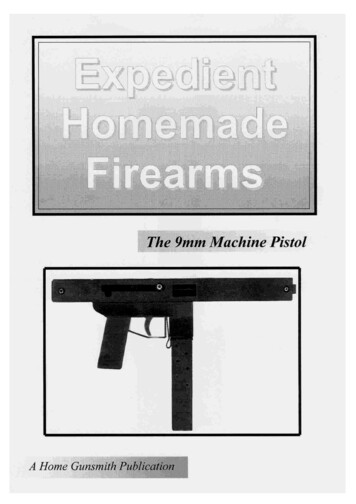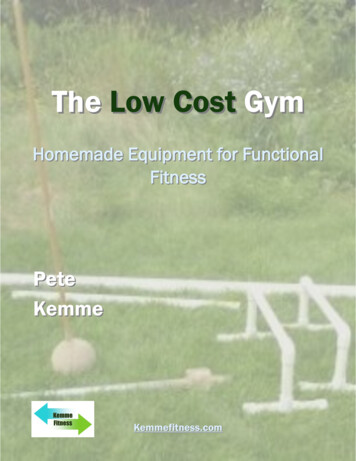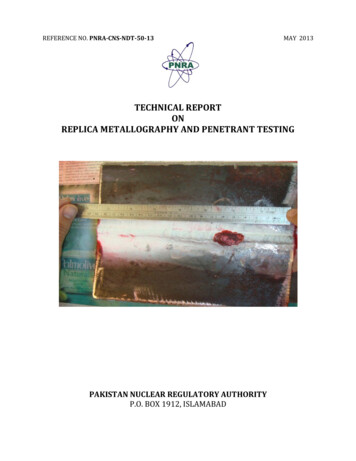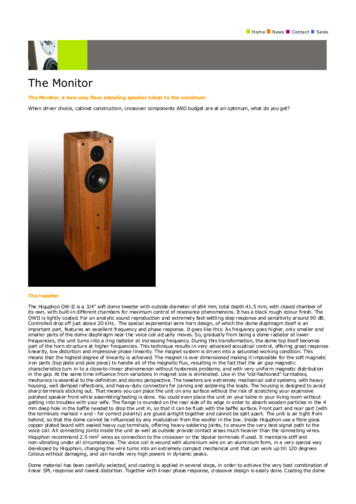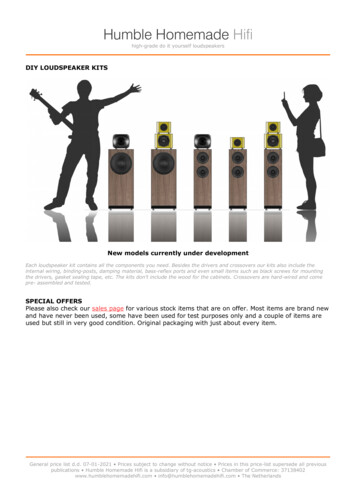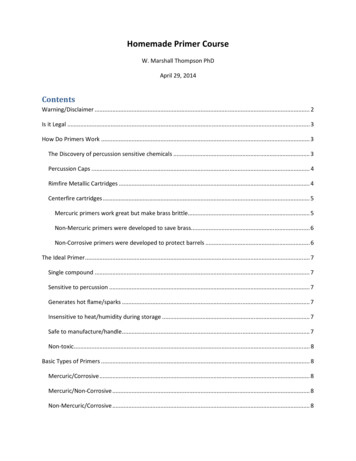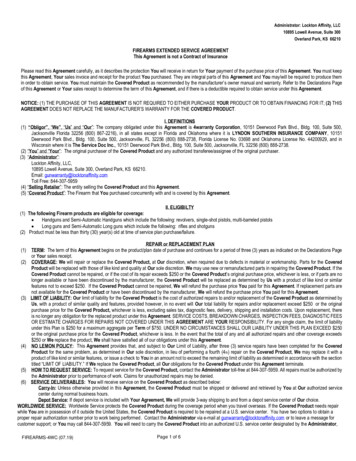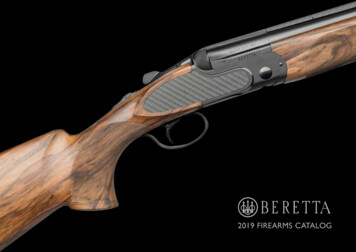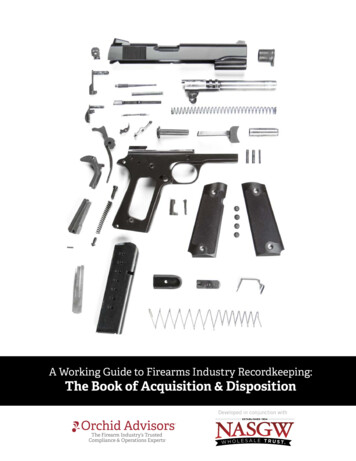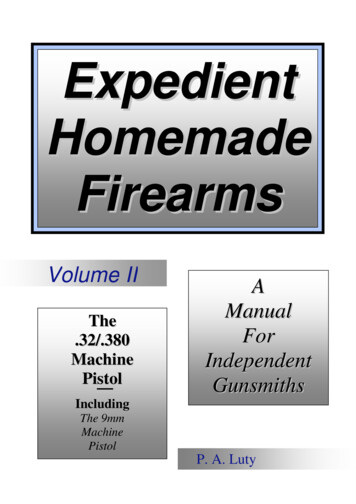
Transcription
0ExpedientHomemadeFirearmsVolume IIThe.32/.380MachinePistolAM anualForIndependentGunsmithsIncludingThe 9mmMachinePistolP. A. Luty
Expedient Homemade Firearms:The Machine PistolBy P. A. Luty (D.F.C)Copyright C.2004 by P. A. LutyA Home-Gunsmith PublicationAll rights reserved. Anyone attempting toreproduce any part of this publication inany form without the express writtenpermission of the author will be tried,sentenced and shot, (and not necessarily inthat order)Printed in England by Bunker Books Inc;Direct all enquiries to:www.thehomegunsmith.comNeither the author nor publisher assumes anyresponsibility for the use or misuse of theinformation contained in this book.For academic study purposes only.
‘Gun control’ has had a long history:“The people of the various provinces are strictly forbidden to have intheir possession any swords, bows, spears, firearms, or other type ofarms. The possession of these elements makes difficult the collection oftaxes and dues and tends to permit uprising, therefore, the heads of theprovinces, official agents, and deputies are ordered to collect allweapons mentioned above and turn them over to the government.”Toyotomi Hideyshi, Shogun, August 29, 1558
CONTENTSForewordIntroductionTools RequiredBuying materialsTubing and materials 8.9.10.11.12.13.14.Lower Receiver ConstructionGrip and Magazine WellMagazine ConstructionTrigger and GuardSear ConstructionUpper ReceiverBarrel AssemblyBreech Block AssemblyThe EjectorMainspring, Guide and Recoil ShieldAssembling the Machine PistolMaking a SlingFinal FinishingTest FiringAPPENDIX AAPPENDIX BAPPENDIX CAPPENDIX DAPPENDIX EAPPENDIX F::::::Machine Pistol Tube SizesTube Sizes for Improvised BarrelsChamber Reamer SuppliersHomemade Reamer.380 ConversionMachinist Drawings915213133414953596167717375777981838789
FOREWORDSo, you would like to know how a homemade firearm is constructed, what types ofmaterials are used, and what tools are required to build the gun?I don’t blame you. It is an interesting subject, but more importantly, a usefulknowledge to have, especially in these days of increasingly oppressive anti - gunlaws. Perhaps this is the first book you have read on the subject, or maybe you havepurchased other ‘‘Homemade Firearm’’ publications only to be disappointed andbamboozled by pictures of an engineer or professional Gunsmith building a gunusing a lathe and milling machine! The gun made by the man who possesses suchequipment is still technically a “Homemade Firearm” because it was made in thehome environment; however, relatively few people have access to such equipment.For most people the term “Homemade gun” conjures up the image of a crudelooking makeshift contraption, held together with sticky tape and glue, more of adanger to its owner than any potential target!The true homemade firearm does not have to fall into either of the above categories.It is perfectly possible to construct a firearm without a degree in engineering, andone which you would not be ashamed of admitting to building.The Expedient Homemade Firearm strikes a happy balance between these twoextremes of construction technology.When the term ‘expedient’ is used to describe the construction of a given product, itdescribes something that can be made with relative speed and using the bestmaterials available in any given time or place.The Expedient Homemade Firearm adheres to both these principles. It is durable,relatively quick to build, does not require the use of special tools and is constructedfrom the best off-the-shelf materials available.Expedient is, therefore, the key word when discussing the subject of the home builtfirearm.
INTRODUCTIONIn this volume of Expedient Homemade Firearms i will endeavour to show how amore compact and lightweight machine pistol can be constructed from readilyavailable off-the-shelf materials.In these days of anti-gun laws, when firearms may have to be hidden away, themore compact and concealable a weapon is the better.The expedient machine pistol is a .32/.380 calibre weapon. The true expedientfirearm is built from the position that no outside influences such as machine tools orprofessional gunsmith’s materials are available. For this reason nearly all majorcomponent parts of the weapon, receivers, barrel, breech block and magazine, areconstructed from readily available steel tubing, eliminating any need for a lathe. Thebarrel, for example, is assembled from a length of seamless hydraulic tubereinforced with a series of steel collars and is smooth-bore rather than rifled. Whilethe accuracy available from the smooth-bore barrel is restricted to relatively closeranges, the relative ease and speed of assembling the expedient barrel more thancompensates for this necessary compromise.Manufacturing a gun magazine using the conventional methods of folding sheetsteel around a form block can be tricky and a time-consuming process. Theexpedient magazine avoids these problems, as once again it is constructed of tubeand only requires a hacksaw, file, and silver solder to assemble it. The magazine isof a single stack design holding 16 rounds. This is less than the capacity of thecommercially produced twin stack design, but again, the relative simplicity ofmanufacture more than compensates for the reduced capacity.Certain parts of the machine pistol, such as the sear, require the use of hardenedsteel. For this reason, I have incorporated certain off-the-shelf products into the gundesign that are as close to the correct steel types requires as possible. Thiseliminates the acquisition and heat treatment of specialised steels which can pose aproblem.I have not included any sights on the machine pistol as they would only be forcosmetic purposes, rather than to make the gun more accurate.
The machine gun is primarily a point and fire weapon. Reliability and simplefunctionality are the main priorities, especially for a weapon that should be kept assimple as possible. In short, I have included only what is necessary to ensure thegun will function as reliably as can be expected.It should be noted that the life expectancy of any firearm built using the type ofmaterials and techniques illustrated in this book will be less than that of one builtfrom the correct steels and to machine tool tolerances. However, due to the easewith which parts,(such as the breech block and barrel) can be made; it is possible tokeep the firearm in permanent working order by having a selection of spare partsavailable and ready for use. A spare breech block and barrel should be regarded asa necessity.WARNINGTHE MATERIAL PRESENTED IN THIS BOOK REPRESENTS THEAUTHORS ATTEMPTS AT DEVELOPING AND BUILDINGHOMEMADE FIREARMS AND DOES NOT NECESSARILY CONDONOR ENCOURAGE THE CONSTRUCTION OF FIREARMS BY ANYINDIVIDUAL OR GROUP.THE CONSTRUCTION OF FIREARMS IN MOST JURISDICTIONS ISILLEGAL. NEITHER THE AUTHOR NOR PUBLISHER ASSUMESANY RESPONSIBILITY FOR THE USE OR MISUSE OF THEMATERIAL PRESENTED IN THIS PUBLICATION. THE TECHNICALDATA PRESENTED, PARTICULARLY ON THE USE OF FIREARMS,INEVITABLY REFLECTS THE AUTHORS INDIVIDUALEXPERIENCES WITH PARTICULAR FIREARMS UNDER SPECIFICCIRCUMSTANCES WHICH THE READER CANNOT DUPLICATEEXACTLY. THE MATERIAL SHOULD, THEREFORE, BE TREATEDAS ACADEMIC STUDY MATERIAL ONLY AND APPROACHED WITHCAUTION. THE COMPLIANCE WITH ANY LAW IS THE SOLERESPONSIBILITY OF THE INDIVIDUAL READER.
TOOLS REQUIRED1.2.3.4.5.6.7.8.9.10.11.12.Electric Drill or Drill PressDrill Bits 1.5 to 9mm diameterHacksawLarge Files, Round, Half Round and FlatAngle GrinderBench GrinderHammerSet square14.2 mm (9/16) Taper Pin ReamerTaper Cutting ToolCountersink ToolLarge ViceThe tools listed above are the minimum required. Obviously the better selection oftools you have at your disposal the easier the firearm will be to construct. A drillpress, for example, while not in the hand tool category, will save you a lot of timewhen drilling holes, etc. It is worth pointing out that a drill press is no moreexpensive than a good quality electric hand drill and if you are considering buying anew drill, I would strongly recommend a drill press with a minimum 3/8” chuckcapacity.If you have access to a lathe, the need to acquire the tubing for the barrel andbreech block will be unnecessary. A lathe is not necessary to construct any part ofthe firearm featured in this book; I merely point it out in the event of such equipmentbeing available to the reader. The time required to build the machine gun will bedependent partly upon the equipment available to the reader and also upon thegeneral ability of the individual concerned. As a general guide, it should be possiblefor the average individual to build the entire weapon in a week to ten days, once thenecessary materials have been acquired. For the individual who has access to alathe, the manufacturing time can be halved.
BUYING MATERIALSAs I mentioned earlier, almost the entire weapon is constructed from steel tubing.The best places to look for the type of tubing we require are tube stockholders, whowill usually have in stock all the tube sizes required for any construction. It should benoted that tube suppliers usually have minimum order charges. I would adviseordering all tube sizes required for construction at the same time to take advantageof the minimum order charges. Many suppliers also have a tube cutting service so Iwould strongly suggest having the lengths of tube cut into three foot lengths for easyof handling and storage, etc. For small quantities of tube, engineering and steelfabrication shops are a good place to look. However, you will not find all the tubesizes required in such places. A list of tube sizes and materials required are suppliedoverleaf. I have marked the occasional item with a (*) to indicate that several of thatparticular item should be purchased in case of mistakes during manufacture.For items such as shaft lock collars, mud wing washers, hexagonal keys/wrenches,socket screws etc, look in the Yellow Pages under “Nut and Bolt” and “EngineeringSupplies” for a stockist near you. It is very unlikely your local hardware shop willstock the items required, and a trip to the correct supplier will be a necessity. Springsteel strip material and spring wire (piano/music wire) is available from any goodmodel engineering shop. Your local spring manufacturer is also a good source forspring wire material.
TUBE SIZES REQUIRED1.30 x 30 x 2mmUpper Receiver2.30 x 30 x 1.6mmLower Receiver3.14.29 x 3.25mmBarrel (SMT)*4.12.70 x 2.03mmBreech Block (SMT/SHT/ERW)*5.25.40 x 12.70 x 1.6mmMagazine6.12.70 x 0.91mmMagazine7.34.93 x 15.88 x 1.6mmMagazine Well8.40 x 20 x 1.6mmGrip9.50.80 x 1.6mmTrigger Guard* Seamless mechanical/Seamless hydraulic/Electric Resistance WeldedMATERIALS REQUIRED1.3” x 2” x 1/8” Steel Plate (Trigger)2.10mm Hexagon Wrench/Key (Sear)*3.½” Shaft Lock Collars x 144.5 and 6mm Shaft Lock Collars x 26.5.5mm dia’ Steel Rod x 24” long (or 7/32”)7.19.05 x 5mm Flat Bar x 25” long (or 3/4 x 3/16 )8.3mm dia’ Steel Rod x 5 ½”long (or 1/8”)9.9.5 x 1.6mm Steel Strip (Sheet) x 6” long (or 3/8”x 1/16”)10.19.05 x 9.5mm Flat Bar x 9” long (or 3/4 x 3/8”)11.20 Gauge Piano Wire (Music Wire) Purchase several rolls12.18 Gauge x 7/16” Spring Steel Strip, 12”long13.20 Gauge x ½” Spring Steel Strip, 8” long14.6mm dia’ Socket Screws (x 11) 9mm long (or 1/4” x 3/8”)
SPECIFICATIONSWeapon TypeMachine PistolCalibre.32/.380Capacity.32 (15) .380 (14)Overall Length18 ¾”Barrel Length9”Weight Unloaded4 lbs 8 ozSightsNoneConstruction MaterialsTube, Collars, Nuts and BoltsMaterial AvailabilityGoodTools RequiredHand only“DESIGN AND DEVELOPMENT”I am often asked questions, by readers of my books, about design anddevelopment issues. A question I often hear is, “Do your gun designsactually work”? I am even sent “design improvement” drawingsoccasionally, by well meaning would-be gun designers!The reader should be aware that the weapons shown in this publicationdo work, in that, they can throw ammunition “down range” at analarmingly expensive rate! The reader, however, should also be awarethat due to personal circumstances, and the fact that building guns iscompletely illegal, little time was lost in the “design and development”stage. The gun designs can, therefore, be improved upon in areas suchas aesthetics, compactness of design and components, and materialsused in construction etc. Despite this, I hope I have lead the way in aparticular area of gun design, making it easier for other “homemadegun” designers to follow, and perhaps improve upon what I have done!
Expedient Homemade Firearms1Lay the copied template sheet on a flatsurface and, using a sharp craft knife, cut outboth templates. The three shaded areas ontemplate No1 are also removed as carefullyL O W E R R E C E IV E Ras possible. It is a good idea to use a ruler toguide the knife, to make cutting out asaccurate as possible. Both templates are nowWe will start building the machine pistol byglued to the receiver tube, as shown below.first constructing the lower receiver. This isCheck that the templates are in as exact anprobably the best place to start because thealignment with the tube as possible, beforelower receiver accepts most of the gunsmarking the position of each recess andworking parts i.e. the trigger mechanism andcontour onto the tube. A scribe or othermagazine.sharply pointed tool is used for this procedure.The lower receiver is cut out, using aThe six crossed circles indicate the positionshacksaw, from an 11 1/8” length of 30 xof the various holes that must be drilled into30mm 16 gauge box section steel tubing.the tube, and these positions must be markedA heavier gauge may be used up to a wallalso. This is accomplished by placing athickness of 2mm,punch, (sharpbut in the interestnail, etc) in theofcentre of eachkeepingtheweapon as light firmlytube is best. First,punchwithacut the tube to a length of
Certain parts of the machine pistol, such as the sear, require the use of hardened steel. For this reason, I have incorporated certain off-the-shelf products into the gun design that are as close to the correct steel types requires as possible. This eliminates the acquisition and heat treatment of specialised steels which can pose a problem. I have not included any sights on the machine pistol .
